
The Diocese of St Albans forms part of the Province of Canterbury in England and is part of the wider Church of England, in turn part of the worldwide Anglican Communion.

St Stephen's Church is a Church of England parish church in St Albans, Hertfordshire, England. It is located to the south of the town centre, at the top of St Stephen's Hill. It is a Grade II* listed building.

St Michael's Church is a Church of England parish church in St Albans, Hertfordshire, England. Much of the building is late 10th or early 11th century, making it the most significant surviving Anglo-Saxon building in the county. It is located near the centre of the site of Roman Verulamium to the west of the modern city.

St Peter's Church is a Church of England parish church. It is located in St Albans, England, at the northern end of the town centre.

St Mary's Church is a redundant Anglican church in the village of Little Hormead, Hertfordshire, England. It is recorded in the National Heritage List for England as a designated Grade I listed building, and is under the care of the Churches Conservation Trust. The church is particularly noted for its Norman door, made of wood and ironwork. It is described as a "work of outstanding importance", and a "rare and precious survival".
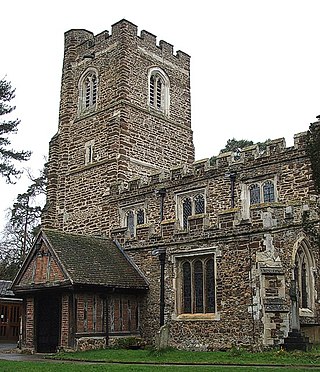
The Church of St Peter & St Paul is the Church of England parish church in Flitwick, Bedfordshire, England. It became a Grade I listed building on 23 January 1961.

St Michael's Church is in Church Lane, North Rode, Cheshire, England. It is an active Anglican parish church in the deanery of Macclesfield, the archdeaconry of Macclesfield, and the diocese of Chester. Its benefice is combined with those of St Mary the Virgin, Bosley, St Saviour, Wildboarclough, and St Michael, Wincle. The church is recorded in the National Heritage List for England as a designated Grade II listed building. The authors of the Buildings of England series describe it as "a charming estate church".

St Mary's Church, Burford, is located near to Burford House in Shropshire, England, about 0.7 miles (1 km) to the west of Tenbury Wells. It is an active Anglican parish church in the deanery of Ludlow, the archdeaconry of Ludlow, and the diocese of Hereford. Its benefice is united with those of eleven other parishes to form the Tenbury Team Ministry. The church is recorded in the National Heritage List for England as a designated Grade I listed building.

St Mary's Church is a Church of England parish church in Hitchin, Hertfordshire, England.

The Church of St Nicholas in Norton in Hertfordshire was originally the parish church for the village of Norton, which today has become a suburb of Letchworth Garden City. The present building dates from about 1109 to 1119, with additions in the 15th century including the tower. Before the Reformation it was a stopping point on the pilgrim route to the Abbey of St Albans and the shrine there.

St Mary the Virgin is the Church of England parish church for East Barnet within the Diocese of St Albans. It is located on Church Hill.

St George's Church is an Anglican church of modern design in the Parish of Norton in Letchworth Garden City in Hertfordshire. Opening in 1964 and arrow-shaped with a 120-foot concrete spire, the congregation are seated in a semi-circle facing the altar. The church building is in the style of the Liturgical Movement following World War II. It was Grade II listed in 2015 for "its striking architectural form, expressed through a diverse range of materials to provide an innovative building of real quality both in composition and detailing."

Holy Trinity Church is the parish church for the village of Weston in Hertfordshire. The church building stands to the south-east of the village on high ground, and is built of flint and coursed ironstone rubble. It was Grade I listed in 1968. In the churchyard is the supposed grave of the giant Jack o'Legs.
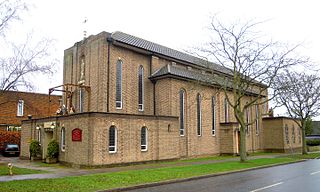
The Church of St Hugh of Lincoln is a Catholic church in Letchworth, Hertfordshire founded by the scholar and priest Adrian Fortescue. The first church was consecrated in 1908 and was dedicated to St Hugh of Lincoln while the modern church which replaced it was built in 1963. It comes under the Diocese of Westminster.

The Church of St Paul in Letchworth in Hertfordshire is the Anglican parish church for the Letchworth Gate area of the town at the top of Pixmore Way. Dating from 1923, with later extensions, it is a 'daughter church' of the nearby Church of All Saints in Willian and comes under the Diocese of St Albans. Built as a 'Victory' church following World War I, the building is the largest war memorial in Hertfordshire.

The Church of St Margaret of Antioch is the Anglican parish church for the village of Bygrave in Hertfordshire. Dedicated to St Margaret of Antioch, the church has been a Grade II* listed building since 1968 and comes under the Diocese of St Albans.
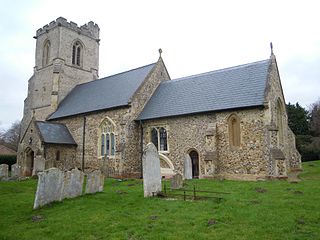
The Church of All Saints is the Anglican parish church for the village of Willian in Hertfordshire. The benefice is united with St Paul's church in nearby Letchworth, although each church has its own parish. It is in the Diocese of St Albans. The church has been a Grade II* listed building since 1954.
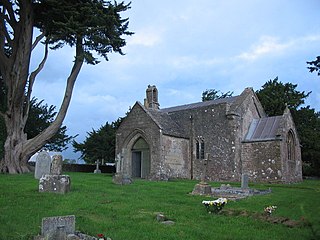
The Anglican Church of St Mary in Chesterblade, Somerset, England was built in the 12th century. It is a Grade II* listed building. It is located 3 miles northeast of Evercreech, and three miles south east of Shepton Mallet.

The Anglican Church of the Blessed Virgin Mary in Ashill, Somerset, England was built in the 12th century. It is a Grade II* listed building.
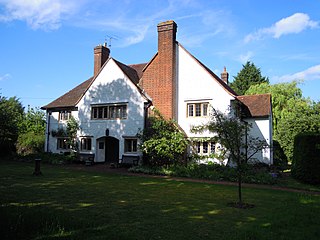
Howgills in Letchworth Garden City, Hertfordshire, England, is a Grade II listed building on the Register of Historic England in use as a Meeting House for the Society of Friends (Quakers).





















